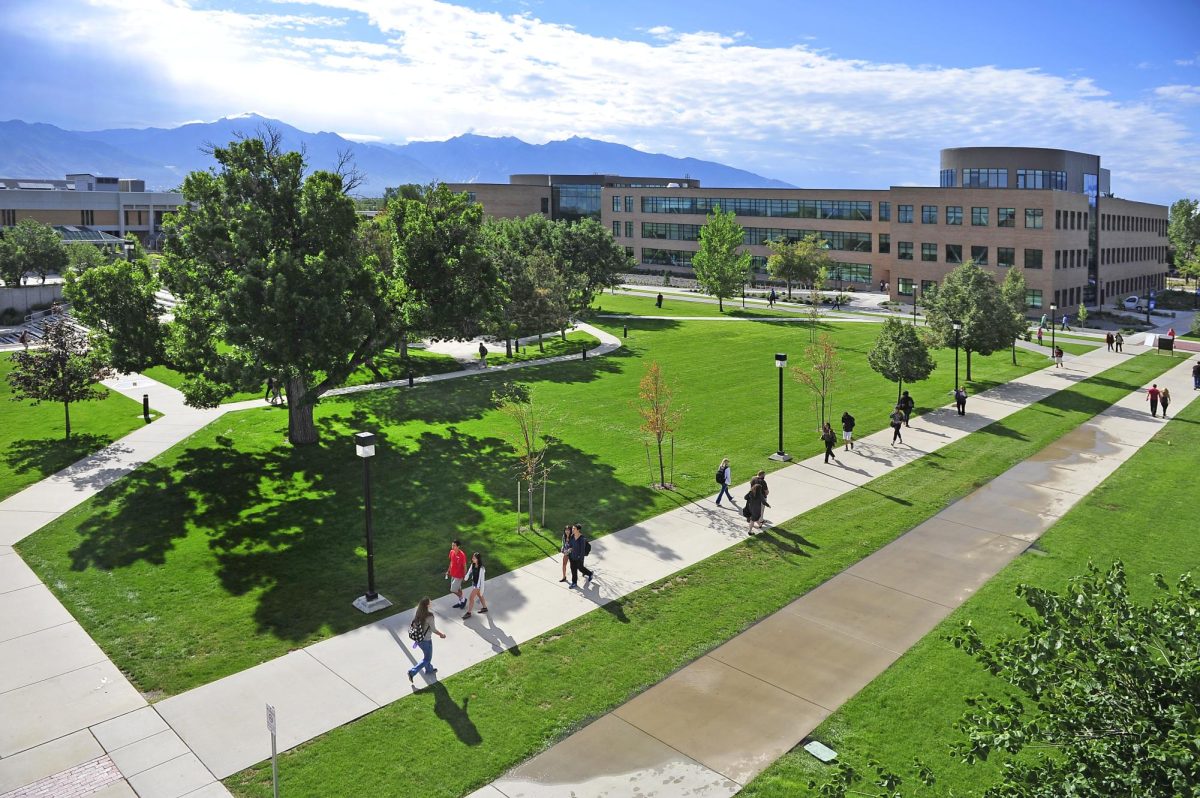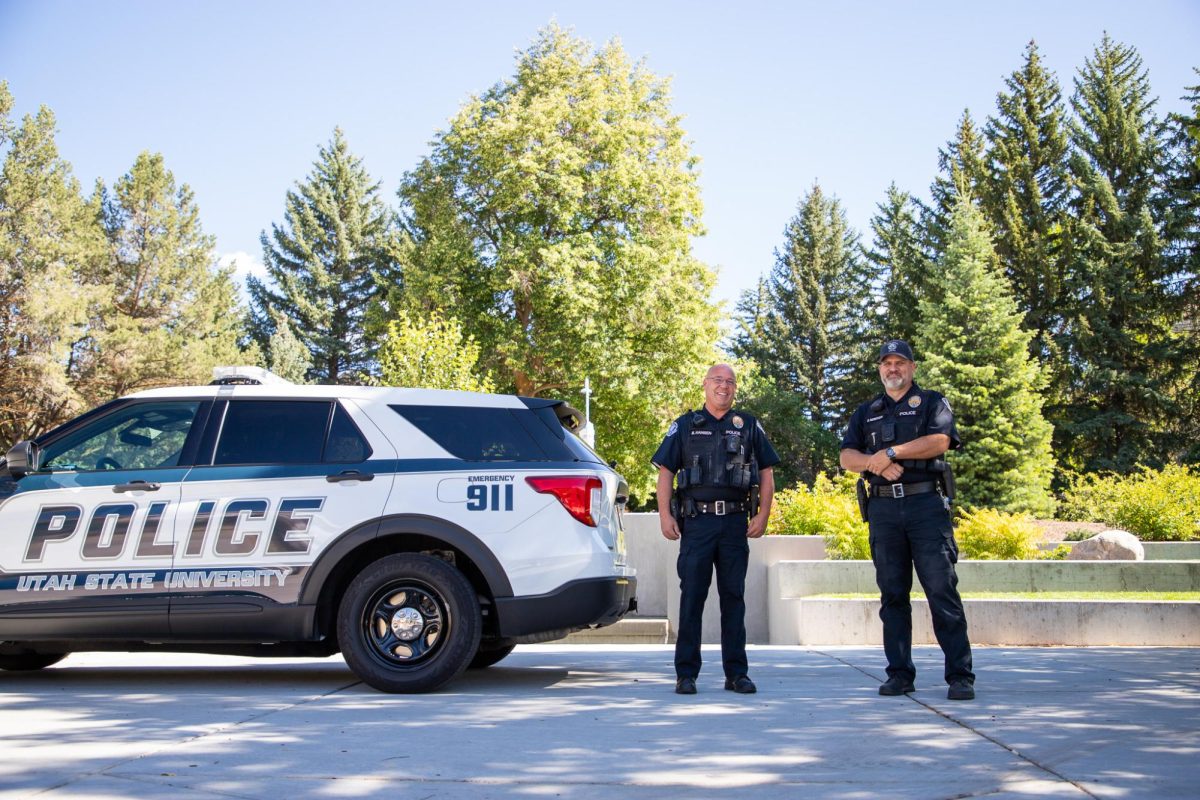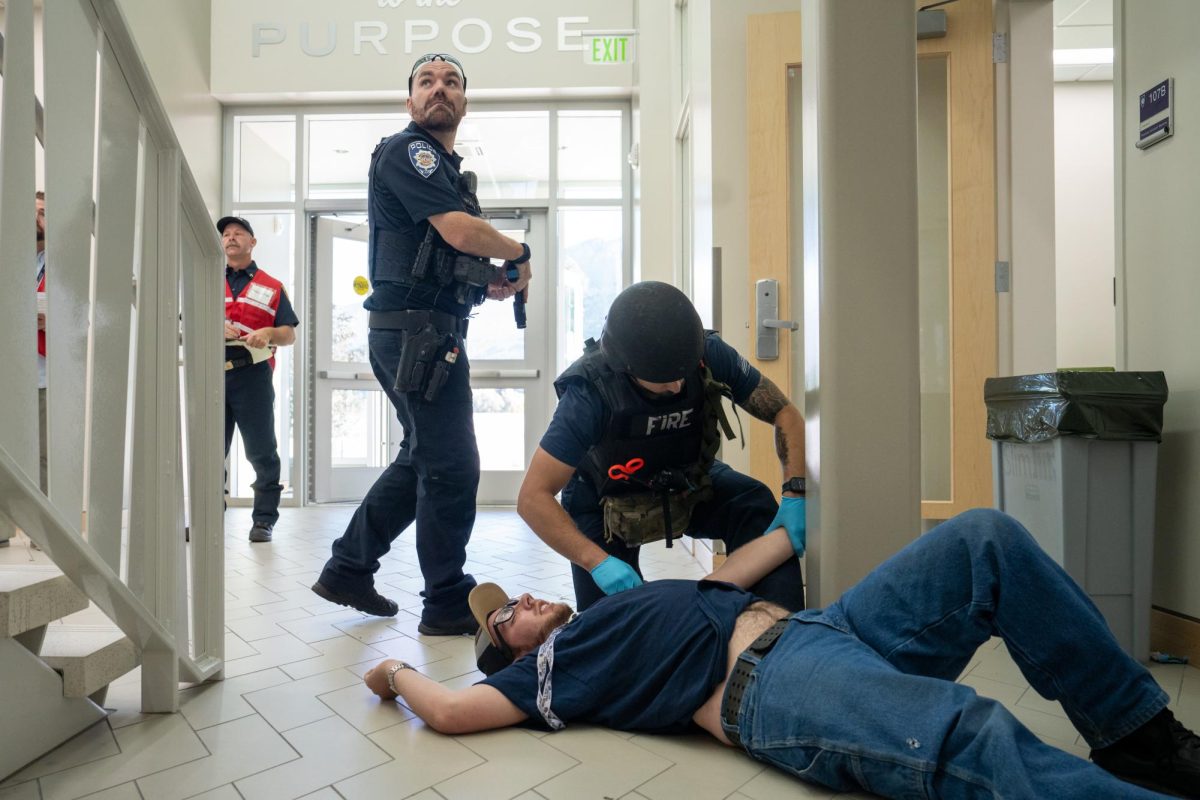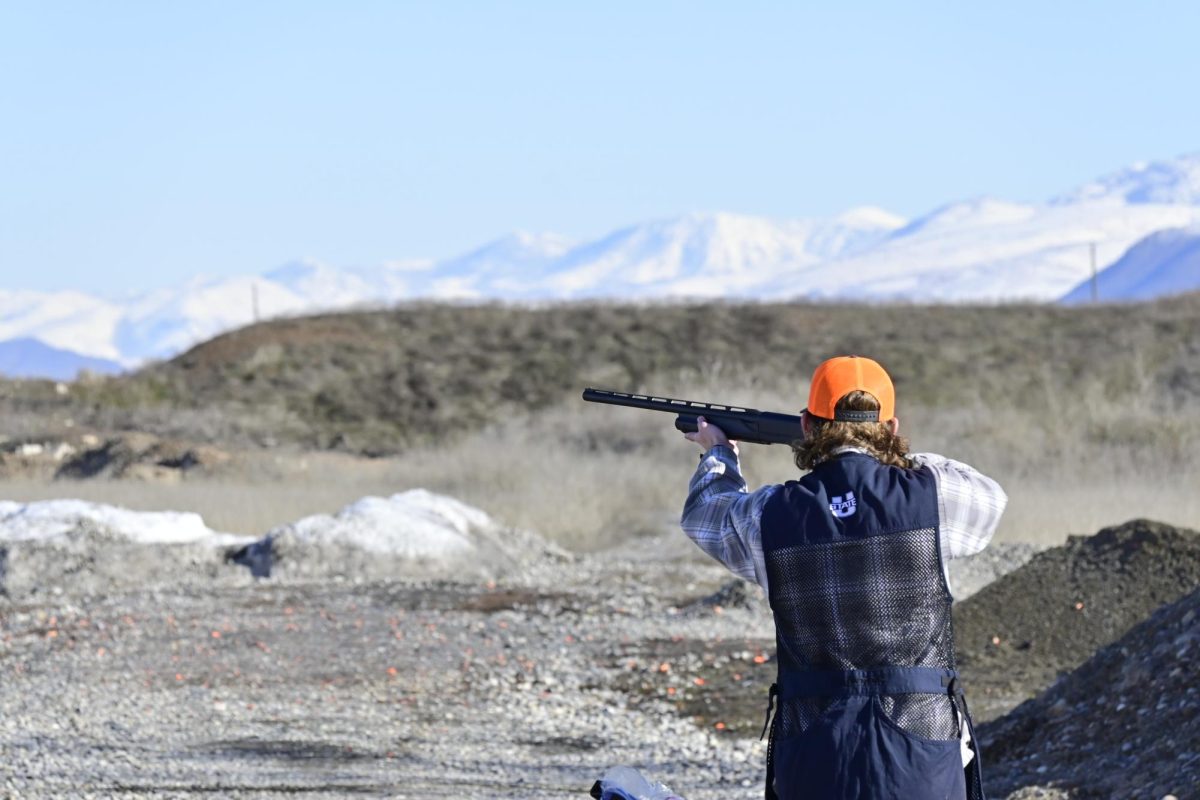This story is jointly published as part of the Utah College Media Collaborative, a historic cross-campus project bringing together emerging journalists from Salt Lake Community College, the University of Utah, Utah State University and Weber State University. The collaborative is an Amplify Utah project with support from PBS Utah.
The winter air outside Logan is sharp and thin on the morning of Feb. 17, and a rapid succession of what sounds like firecrackers breaks the prevailing sound of a frigid, unyielding wind.
The source of the noise is a combination of pistols, rifles and shotguns fired by gun owners at Cache Valley Public Shooting Range, which sits just a few miles west of downtown Logan and houses two firing ranges.
Inside the building, the Utah State University Shotgun Shooting Club prepares for their weekly practice. Haedyn Buchanan readies her attendant shooters for the drills of the day, which will subsequently train them for an upcoming national clay target competition.
Utah State’s shotgun club is one of two gun clubs at the four colleges in the Utah College Media Collaborative, along with the University of Utah’s marksmanship club. The other two colleges in the collaborative, Weber State University and Salt Lake Community College, do not have shooting clubs.
But all it takes for a club to form is someone like Buchanan, USU shotgun shooting club president, who has been shooting rifles since age 8 and shotguns since she was 15.
“Shotgun [shooting] is what I did growing up,” said Buchanan, a senior at USU studying technical communication and rhetoric who founded the club with one other student in 2021. “There’s a youth shooting team based here In Logan and over 10 youth shotgun clubs in Utah. It gets competitive, and you can go to nationals as a kid.”
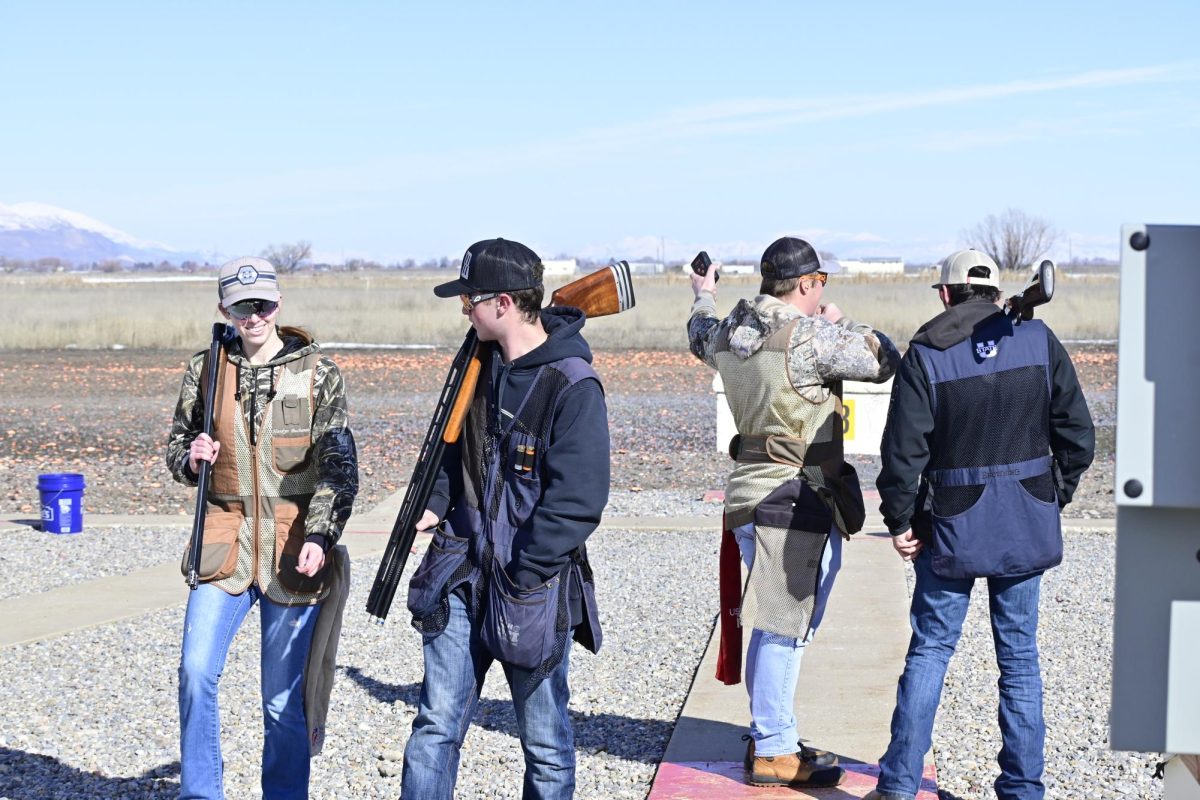
The Sport of Shooting
The team Buchanan leads has 12 members, but not everyone competes. The club is separated into “casual” and “competitive,” and the competitive squad has two important annual events that they take part in each year.
In its short history, the shooting club has already found success, bringing home multiple trophies, medals, and even a victory belt.
At each regional or national competition, and in practices leading up to major events, the aim is to shoot clay targets with a shotgun. Going one at a time, shooters stand at the end of concrete walkways that lead partially out into a muddy field, with five separate positions in total.
When they’re ready, the shooter yells, “Pull.” Someone with a remote clicks a button, and a clay disc with a bright orange streak flashes through the air at an angle.
“I love the discipline of [shooting],” said Chandler Wilson, a club member and junior at USU studying electrical engineering. “And there’s just so many small mechanics that go into shooting and practicing shooting.”
Wilson had never shot a shotgun before joining the club in his freshman year. He said he appreciates the challenge, adding that “figuring out how the guns work is also fun.”
The variety of shooting sports is evidenced in the contrast between the clubs at USU and the U, the latter of which hosts a collegiate pistol team, rather than a shotgun sports club. Instead of shooting moving clay targets, members of the pistol team fire one-handed at stationary paper bullseyes, which look like dart boards.
Matt DeLong, faculty in the physics department at the U, helped form the club in 1994 and still serves as their most involved coach, leading practices weekly in the basement of a building on the U campus. Like the USU shotgun club, the U pistol team competes regularly.
This year, of the pistol team’s 14 participants, six shooters earned spots at collegiate nationals, which took place in Georgia from March 20 to 23. The Utes took home the third place team trophy for air pistol. Of the six or seven major precision shooting events worldwide, the U’s team participates in three: air pistol, standard pistol and sport pistol.
“We have a program that generates athletes,” DeLong said.
And for all three events, the safety rules are clear and even printed in red on the wall of the range at the university. Range safety officer Hyrum Davis said the three main rules are: “Always keep the gun pointed in a safe direction, always keep your finger off the trigger until you’re ready to fire and always keep the gun unloaded until ready to use.”
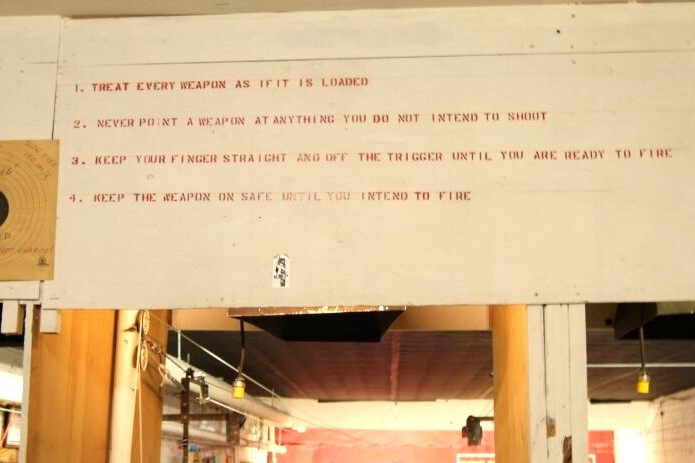
fire. (Photo by Bao Lam | SLCC’s The Globe) (Bao Lam)
Maintaining Safety Through Diligence and Knowledge
Wilson said an appreciation of guns comes with the necessity of knowing how they work and how to stay safe around them. His fiancee used to be nervous around firearms, but as he introduced her to shooting safety, Wilson said she’s started to feel more comfortable around guns.
“A lot of people I’ve met who are scared of guns have never touched one before,” Wilson said. “And that’s why they’re scared.”
USU shotgun club member Wyatt Montgomery echoed Wilson’s sentiment. He said having exposure to guns is key to destigmatizing the sport of shooting.
“There’s a bad rap around guns because you don’t hear about them until something bad happens,” Montgomery said. “Seeing it as a sport makes it a little more relatable … Like basketball or football, it’s a competitive sport, so you can go out and watch it and be perfectly fine with it. You don’t [often] hear about guns in that context, so there’s a weird dynamic of them being ‘dangerous.’”
Kade Meyer, another USU club member, said while guns are available to rent at the range his team frequents, personally owning a gun helps team members know how to safely participate in the sport of shooting.
“It’s better for members to have their own guns,” Meyer said. “It builds that safety factor that comes with being experienced, and so we can [all] trust that we’re being safe when we’re competing.”
The dorms at USU allow guns to be stored in locked containers, Wilson explained, adding that one must seek permission from the dorm first. Wilson also emphasized the importance of disassembling his guns when they’re not in use.
Wilson said he rigidly follows gun safety rules, even when his gun is disassembled. This includes having a lock on his gun case and on the gun itself, always pointing it in a safe direction, and treating his guns as if they were loaded — even when he’s certain they’re not.
But responsible gun ownership, aside from being about safety, is also about accountability, according to Amir, a U pistol team competitor studying mechanical engineering who wished to have their last name kept private.
“Always know where your own firearms are and who can have access to them,” Amir said. “And especially narrow that group down. If the gun is inside your house, limit it to your family and make sure your house is secured.”
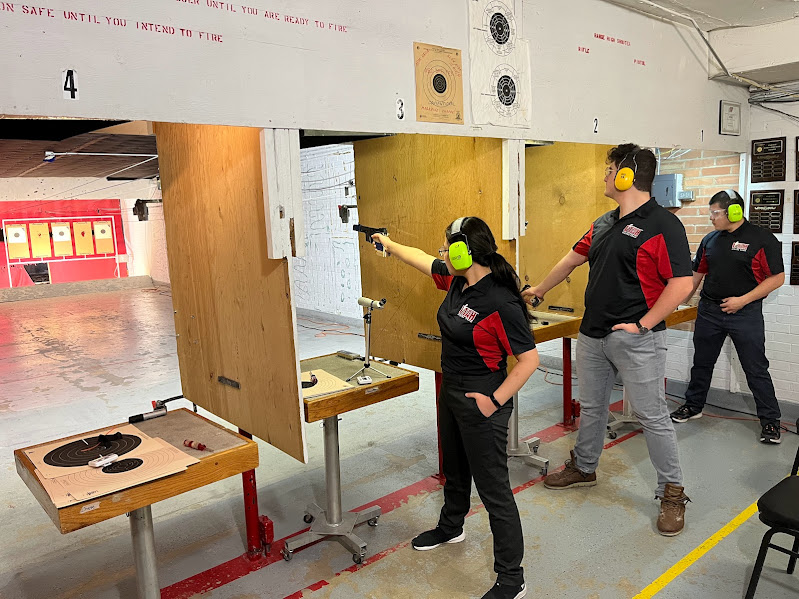
Portillo shooting in a qualifier for nationals at the U pistol range on Feb. 9, 2024. Their scores decided if they were invited to collegiate nationals for precision pistol shooting, which was held in Georgia from March 20 to 23. (Photo by Kyle Forbush | SLCC’s The Globe) (Kyle Forbush)
Benefits Beyond the Shot
Wilson said the competitive team has brought numerous benefits to his life.
“Shooting has been a big stress reliever,” he said. “I had a hard time adjusting to college when I first came to USU … then I found this team.”
As the USU club president, Buchanan said she has learned a lot about organization and communication, which has also aligned with her degree path.
“It has definitely taught me a lot of leadership skills,” she said. “It has especially helped me with my job now – how to have communication skills, be able to talk with a lot of people, and organize things like practices and big competitions.”
In his three decades of coaching the U pistol team, DeLong has seen shooting improve competitors’ self-confidence.
“The same quasi-academic skills that make you a good shooter also make you a good student in other fields,” DeLong said. He said the student athletes he coaches on the pistol team have increased aptitude for focus, concentration and time management from being involved in the sport of precision shooting.
“You know how, in other college sports, the graduation rate among athletes is considered very important?” DeLong said. “Well, as far as I know, since [the U team] was formed, we have had a 100% graduation rate.”
Kyle Forbush reported and wrote this story as a journalism student at Salt Lake Community College.







